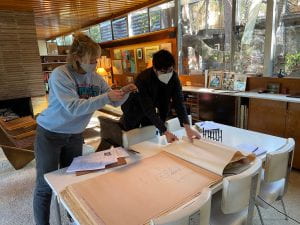Feng Shui as Cultural Heritage Cindy Olnick 00:00Today on Save As… Haowen Yu 00:01It’s not only like letting you know what it’s ahead of you, but also a way to change the nature, to reshapes a nature, to reshape someone’s Feng Shui.…
Tag: cultural heritage
Every Fixture Tells a Story: Neutra’s Reunion House

When is a light fixture not just a light fixture? When it helps tell the story of a remarkable home designed, and lived in, by one of the twentieth century’s greatest architects.
The 1951 Reunion House in L.A.’s Silver Lake neighborhood was designed on spec by Richard Neutra. It housed Neutra and his family as his home/studio down the street was rebuilt after a fire, and it served as the long-time home/studio of his son, architect Dion Neutra.
In this episode, we hear how students Brannon Smithwick and Jesús (Chuy) Barba Bonilla learned about materials conservation by poring over switch plates and climbing on the roof of Reunion House. We also talk with instructor Peyton Hall, FAIA and Sian Winship of the Neutra Institute for Survival through Design, the home’s new steward. If you think studying lighting, roofs, windows, and wood is boring, think again. This episode will give you a new appreciation of the materials in a historic home—with a love story thrown in for fun.
Is Leimert Park L.A.’s Most Significant Neighborhood?
Is Leimert Park the most significant neighborhood in Los Angeles? Katie Horak thinks it might be. “I don’t think there’s any neighborhood in the city that tells so many different important stories about our history as a city, and that really has the integrity to still tell that story,” she says in this episode of Save As. A USC alum, principal at Architectural Resources Group, and adjunct professor, Katie took her students out of the classroom and into the neighborhood to document Leimert Park’s remarkable architectural and cultural heritage.
We also talk with three of Katie’s students—Zongqi Li, Emily Varley, and Kira Williams—about what they found on their adventure. They unraveled a mystery about how Leimert Park developed, saw how persistent racism affected African American and Japanese American residents, and traced the evolution of schools and churches. You’ll hear why Katie considers Leimert Park so important—and you might even agree.
Last chance for the season! Take our 3-minute survey and enter to win a Save As mug!
Boots on the Ground: Archaeology and Community at Manzanar
Last month, about ninety volunteers spent a weekend excavating the former hospital site at Manzanar, a World War II incarceration camp about 225 miles north of Los Angeles. Some of those volunteers were students in Mary Ringhoff’s Cultural Resource Management class. One of those students was Save As producer Willa Seidenberg, who interviewed people on site about why they travel from near and far to care for this site of tragic memory. In this episode, we dig into the study of archaeology with Mary, hear Willa’s great reporting, and talk with student Dani Velazco about what she got out of the experience (besides getting very, very dirty).
Disco and Diversity in Armenian L.A. Cindy Olnick 0:00 Today on Save As a warning: this episode may cause hunger and the urge to dance. Trudi Sandmeier 0:14 Welcome to Save As a podcast that glimpses the future of heritage…
Disco and Diversity in Armenian L.A.
You may know that Greater Los Angeles has the largest Armenian population outside of Armenia. But you might think it’s concentrated in the city of Glendale and Hollywood’s Little Armenia. Recent alum Erik Van Breene found pockets of Armenian Americans throughout the county while researching his thesis, Not So Little Armenia: Conserving Armenian Heritage Sites in Los Angeles. In this episode, Erik shares how these enclaves formed in waves of immigration from the 1910s through the 1990s. He also gives us a glimpse of the vibrant Armenian economy encompassing food, media, and music–including a recording studio that drew Armenian artists from around the world in the 1970s. That means disco, which you do not want to miss. And he makes the case for mapping and more to conserve Armenian sites before it’s too late.
Beit Olam: The Forever Homes of East L.A.’s Jewish Cemeteries
Cemeteries mean many things to many people. In this episode, we talk with alum Rachel Trombetta about her thesis, Beit Olam: A Home Everlasting–The Jewish Cemeteries of East Los Angeles. Rachel shares the history of Jewish congregations in Los Angeles, how they moved away from the central city over the years, and what that means to the burial grounds established as their “forever homes.” She discusses distinct features of Jewish cemeteries and the specific challenges of conserving cemeteries in general. And she shares her unusual path to heritage conservation from the world of TV and film locations.
